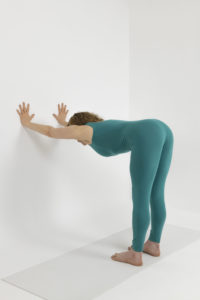
by Nina
In my post Back to Basics: The Four Essential Physical Skills for Healthy Aging, I wrote about why, for a truly independent life as you age, you need a combination of four basic physical skills: strength, flexibility, balance, and agility. Today I’m going to focus on flexibility by providing you with an overview of all the information we have on our blog about why and how to maintain flexibility as you age.
It’s worth saying even though yoga stretches are often done in classes so you can warm up to do more demanding poses, from our point of view flexibility is important not so you can do certain yoga poses. Instead, flexibility is essential to allow you to take care of yourself when you’re elderly (the typical examples used are being able to dress yourself and to reach for objects you want to grab. And it’s also very important—though this is less frequently mentioned— to allow you to continue to do the things you love, whether hiking out in nature, gardening or fixing up your house, playing with your favorite kids or pets, or even continuing to play your favorite sport.
As we age, our flexibility naturally decreases. I’ve really noticed this in myself in the last 10 years since I started writing for this blog! Although some of this loss of flexibility is due to age-related changes, a sedentary lifestyle can accelerate the process. On the other hand, using yoga to cultivate flexibility as you age allows you to maintain range of motion in your joints, which enables you to move your limbs and spine with ease so you can reach, bend, or twist as needed. Being flexible also helps you move smoothly and gracefully, rather than stiffly and awkwardly, which allows you to feel both more comfortable and more confident in your body. Maintaining flexibility also helps you stay healthy because preserving the range of motion in your joints helps fostering joint health (joints are nourished through movement) and can improve arthritis symptoms. I myself include stretching poses in all my sequences these days for every single one of those reasons!
For those who want to learn more about this, we have a ton of information already on the blog. These articles fall into two categories: general background information flexibility and sequences targeting certain areas of the body.
Background Information on Flexibility
What is Flexibility, Anyway? by Baxter explains what flexibility is and describes how and why each of us differs in our natural flexibility
Flexibility and Aging by Nina describes how aging influences your flexibility and identifies which aspects of flexibility you can influence with your yoga practice.
Flexibility Varies: Are You Tight or Flexible? by Baxter describes how and why flexibility varies among individuals and allows you to assess your own flexibility in specific areas of your body.
How Much Stretch is the Right Amount? by Baxter discusses whether you should really stretch to your “edge” or not
Healthy and Unhealthy Stretching Sensations by Nina describes how to tell if you’re stretching in a healthy way or doing something that could potentially cause injury
Tension versus Compression: The Safety Line of Yoga by Baxter discusses how to stretch safely by tuning into the different sensations in your joints
Techniques for Cultivating Flexibility by Nina gives basic guidance for what and how often you should practice to maintain flexibility as you age, including how long you should hold your poses
Flexibility Sequences
Although just about every yoga sequence includes some amount of stretching, if you want to focus specifically on maintaining or improving your flexibility, here are some sequences that focus specifically on flexibility.
Featured Sequence: Lower Body Flexibility Practice is designed to help you cultivate flexibility in your lower body
Featured Sequence: Upper Body Flexibility is designed to help you cultivate flexibility in your upper body
Featured Sequence: Opening Tight Shoulders is designed to help those who are naturally tight in the shoulders
Friday Q&A: Opening Your Hips Without Knee Pain provides a short sequence for those who are naturally tight in the hips but cannot do typical “hip openers” due to knee pain
Friday Q&A: Stretching a Tight Ankle provides information about how stretch your ankles
• Follow Yoga for Healthy Aging on Facebook and follow Nina on Instagram •Pre-order Yoga for Times of Change: Practices and Meditations for Moving Through Stress, Anxiety, Grief & Life’s Transitions here. • Order Yoga for Healthy Aging: A Guide to Lifelong Well-Being here.


this is PRICELESS! Thank you! I stretch for flexibility and strength 7x week now – and the difference in how I feel and move is astounding. And it’s all due to you, Nina – so thank you!
and…btw.. I’m forwarding this to all my friends who DO NOT do this, in hopes it will spur them on. Flexibility is, in my opinion, even more important than strength (you may disagree). It’s of no use to me to be able to lift 100# if I lack the mobility to turn around.